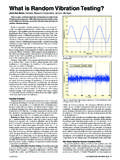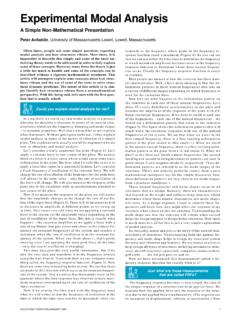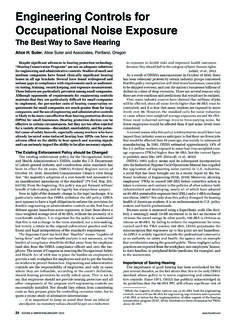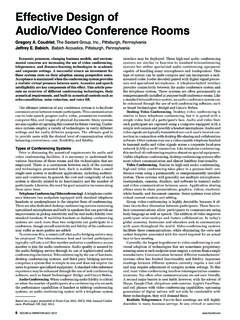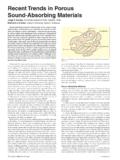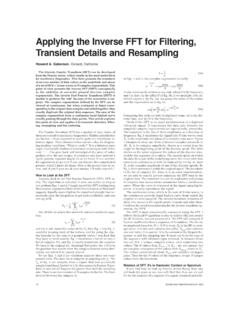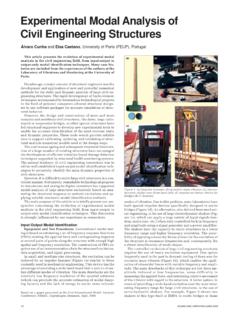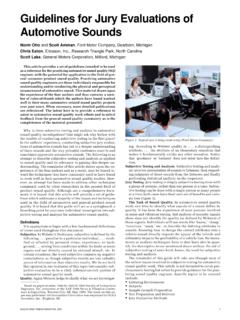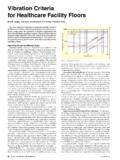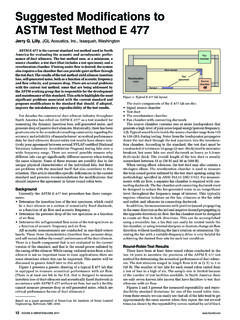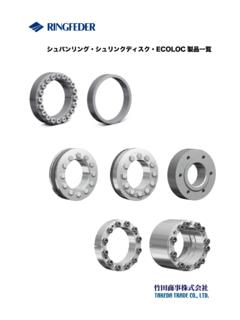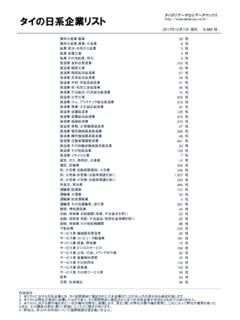Transcription of The ‘Real’ History of Real-Time Spectrum Analyzers
1 SOUND AND VIBRATION/JANUARY 2007 Real-Time Spectrum analysis is used to predict and analyze mechanical faults and failures in rotating machinery to analyze vibratory motions of components, systems and structures; to ana-lyze the noise constituents in these systems; and for many other purposes. Real-Time Spectrum analyzer (RTA) development has a 50-year History that involves overcoming numerous technical bar-riers, challenging measurement techniques and physical obstacles. This article travels down memory lane from the earliest days in the development of these instruments at the Applied Research Laboratories of Columbia University to some of the latest product offerings.
2 The many individuals that have contributed to this his-tory and their accomplishments are 1957 the US Air Force accepted delivery of a Real-Time Spectrum analyzer with a Coherent Memory Filter system from researchers at Columbia University. This instrument simulated a bank of parallel fi lter/detectors, providing the constant-band-width Spectrum of an applied analog input signal. This fi rst RTA was implemented using glass acoustic delay lines and provided Real-Time processing from less than 1 Hz to 40 kHz. A commer-cial enterprise, Federal Scientifi c Corporation, was spun off to develop this exciting new technology.
3 It was founded by Henry Bickel, Reinhold Vogel, Joe Flink, Art Citrin, Mike Laviola and Bill Brookner and located at 615 West 131st Street in New York City. They obtained a patent on the time -Compression methodology that allowed a single fi lter and heterodyning electronics to produce a Spectrum in real time . The name Coherent Memory Filter gave way to Simoramic and eventually to the familiar trademark, Ubiquitous (thank you, Dick Rothschild). Early Federal Scientifi c employees developed and refi ned the time -compression or deltic RTA. Joe Deery began his techni-cal career in the Navy, achieving the rate of E6 as an electronics technician in four years.
4 He was the lead technician on a ship that con-trolled troop landings with millions of dollars of equip-ment. Double Bachelor s De-grees (in Electrical Engineering and Chemistry) followed the Navy experience. After eight years as a Calibration Engi-neer at General Electric and one year as a Systems Engineer with RCA on the Ballistic Missile Early Warning System (BMEWS) program, he decided to make a career his own words I began a life of selling sophisticated dynamic measurement instrumentation, this included RTAs as a rep with Scientifi c Devices and J.
5 E. Cuesta & Co. in the Pennsyl-vania-New Jersey area. Subsequent sales management positions included the sunny days as Sales Manager at Pulse Dynamics, VP of Sales at Nicolet Scientifi c, Sales Manager at Ballantine Labs, General & Sales Manager at Noise Unlimited and Sales Manager at LeCroy. The sun s brilliance then diminished; I joined the dark side and became a Regional Sales Manager for Data Physics. Today, my rep company, AIM&C ( ), sells dynamic testing systems, instrumentation and transducers to the test and measurement community. We also sell thermal oxidizers, tanks, valves, piping, reactors and more to the chemical processing industry.
6 The real History ofReal- time Spectrum AnalyzersA 50-Year Trip Down Memory LaneJoe Deery, AIM & C, Newfoundland, New JerseyArtwork from Nicolet Application Note 11: How to Balance with your Real-Time Analyzer drawn by Lee Bjong in wise man of the West: Tony Keller, early USAF White Sands Federal Simoramic user, eventual Vice President of Spectral wise men of the East: Henry Bickel, Arthur Pini, Reinhold 40th ANNIVERSARY ISSUE 551960s DevelopmentsThe first commercial RTA from Federal Scientifi c was the UA-7 Ubiquitous Spectrum Analyzer. The engineering team had blinders on when it came to mechanical applica-tions and they only projected the sale of about 100 sets to Electronic Warfare and mili-tary Dynamics, under the direction of Laurie Burrows and Hugh Ness, realized the breakthrough that Federal Sci-entifi c had made and entered into a license agreement to produce a product equivalent to the UA-7, which ultimately became the SD 301.
7 These early RTAs processed data up to 20 kHz through a single fi lter that acted as 500 fi lters in 50 msec. These systems had street sale prices in the $35,000 it licensed the UA-7 to Spectral, Federal had an improved model under development. This was introduced (interestingly) as the UA-6 and featured a greater frequency range to 40 kHz. Spectral was furious about this new product offering from Federal, and a legal battle ensued. Spectral placed the highest level of engineer-ing technology on developing RTAs for the environmental testing, rotating machinery, automotive and related markets.
8 Federal/Spec-tral sales arguments included debating the benefi t of dithering the ADC with random noise and a 2 dB difference in dynamic range (48 to 50 dB).Other scientists who performed work with the group at Columbia University started Saicor, which was ultimately acquired by Hon-eywell. Another company, EMR Hatboro, introduced an analyzer that held a spot on the stage into the 70s for about four to fi ve years. Multiple window functions were its claim to glory. Princeton Applied Research, which was known for its boxcar integrators, branched out and developed an RTA as this time , 85% of the RTA commercial market was divided be-tween Spectral Dynamics and Nicolet Scientifi c, which purchased Federal Scientifi c.
9 The lion s share of sales was registered by Spec-tral. Spectral made a major breakthrough for the Navy. They integrated an RTA and special waterfall display hardware with passive sonar to produce the AN/BQR-20 system. This sonar analysis system (and its successors) became stan-dard tactical equipment on all submarines. Spectral sold many hundreds over a ten to fi fteen year period. The SD13151 waterfall display was designed by Carl Dubois for sonar made a half-hearted effort to get into the subma-rine sonar business with little success. Their fi sh-bowl ad-vertisement raised the Na-vy s ire and had to be quickly withdrawn to preserve good working relationships with the many Navy laboratories Federal serviced.
10 However, they did contribute directly to the submarine sonar effort by innovating a new instrument called a Frequency Transla-tor. The Frequency Translator was an accessory for an RTA. It used analog up/down het-erodyning to accomplish what is now called Zoom spectral analysis. The translator al-lowed the RTA to analyze a narrow frequency band with very high 1965, Cooley and Tukey at Princeton University pub-lished their historic paper on the computation of the FFT. This development allowed a 1024 point FFT transform (512 lines) to be processed in one one-hundredth of the time previously required.
